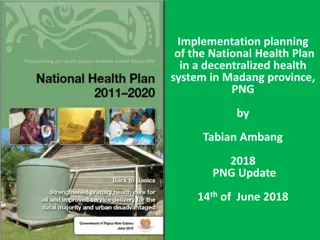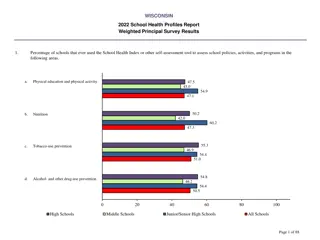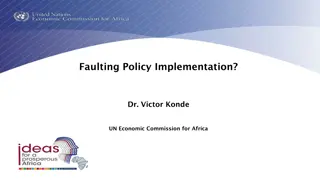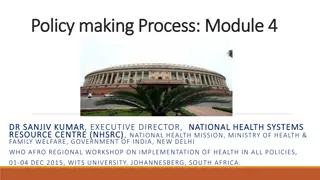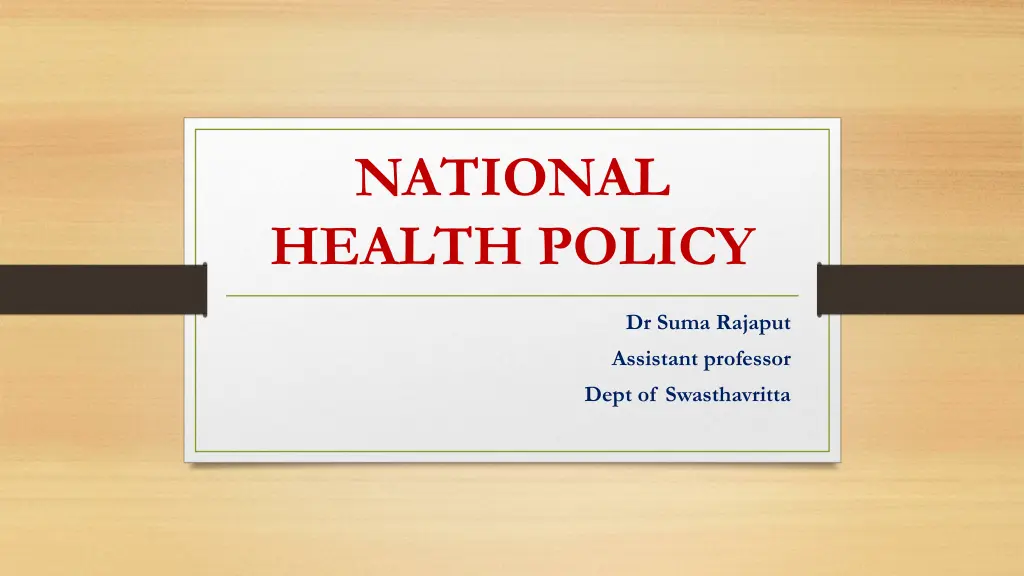
National Health Policy Overview
Explore the journey of India's National Health Policy from 1983 to present, highlighting key objectives and strategies to achieve improved public health outcomes. Learn about initiatives aimed at promoting health awareness, providing essential services, and enhancing healthcare infrastructure. Discover the milestones set for reducing mortality rates, improving life expectancy, and ensuring access to safe drinking water for all.
Download Presentation

Please find below an Image/Link to download the presentation.
The content on the website is provided AS IS for your information and personal use only. It may not be sold, licensed, or shared on other websites without obtaining consent from the author. If you encounter any issues during the download, it is possible that the publisher has removed the file from their server.
You are allowed to download the files provided on this website for personal or commercial use, subject to the condition that they are used lawfully. All files are the property of their respective owners.
The content on the website is provided AS IS for your information and personal use only. It may not be sold, licensed, or shared on other websites without obtaining consent from the author.
E N D
Presentation Transcript
NATIONAL HEALTH POLICY Dr Suma Rajaput Assistant professor Dept of Swasthavritta
Introduction HEALTH: A state of complete physical, mental and social well being and not merely the absence of disease or infirmity. POLICY: Policy is a system, which provides the logical framework and rationality of achievements HEALTH POLICY: Health policy of a nation is its strategy for controlling and optimizing the social uses of its health knowledge of intended objectives. decision making for the
India had its first national health policy in 1983 The Ministry of Health and Family Welfare, Govt. of India, evolved a National Health Policy in 1983 till 2002. The National Health Policy of 1983 and the National Health Policy of 2002 have served well in guiding the approach for the health sector in the Five-year plans.
NHP 1983 Primary objective was to attain the goal of health for all by 2000, by establishing an effective and efficient heath care system which is accessible to all the citizens especially vulnerable groups like women , children and under privileged
Creation of greater awareness of health problems and means to solve problems Supply of safe drinking water and basic sanitation using technologies that people can afford To reduce the imbalance in health services by concentrating more on the rural health infrastructure
Establishing health management information system to support health planning and health programme Provision of legislative support to health promotion and protection Concerned actions to combat wide spread malnutrition Research is alternative method of health care delivery and low cost technologies Co-ordination of different system of medicine
Reduction in infant mortality rate from 125 in1983 to below 60 by 2000AD To raise the life expectancy at birth from 52.6 in 1983 to 64 by 2000AD To reduce crude birth rate from around 35 in 1983 to 21 by 2000AD To reduce the death rate from 14 in1983 to 9 by 2000AD To achieve a net reproductive rate by 1 by 2000AD To provide potable water to the entire rural population by 2000AD
NHP 2002 According to this revised policy , government and health professionals are obligated to render good health care to the society Use of health services to a large group rather than a small group Achieving an acceptable standard of good health of Indian population Decentralizing public health system by upgrading infrastructure in existing institutions Ensuring a more equitable access to health services across the social and geographical expanse of India
Enhancing the contribution of private sector in providing health services for people who can afford to pay Giving primacy for prevention and first line curative initiative Emphasizing rational use of drugs Increasing access to tried system of traditional medicine
Goals of NHP 2002 2003 Enactment of legislation for regulating minimum standard in clinical establishment / medical institution 2005 Eradication of polio and yaws Elimination of leprosy Increase state sector health spending from 5.5% to 7% of the budget
Establishment of an integrated system of surveillance , national health accounts and health statistics 1% of the total budget for medical research Decentralization of implementation of pubic health program
2007 Achive zero level growth of HIV/AIDS 2010- Elimination of Kala- Azar Reduction of mortality by 50% on account of tuberculosis , malaria , other vector and water borne disease Reduce prevalence of blindness to 0.5%
Reduction of IMR to 30/1000 live births and MMR to 100/lakh live births Increase utilization of pubic health facilities from current level of <20% to > 75% Increase health expenditure by government from the existing 0,9%to 2.0% of GDP Increase share of central grants to constitute at least 25% of total health spending
Further increase of state sector health spending from 7%to 8% 2% of the totl health nudget for medical research 2015- Elimination of lymphatic filariasis
Need of NHP 2017 Now 14 years after the last health policy, the context has changed in four major ways. First, the health priorities are changing. Although maternal and child mortality have rapidly declined, there is growing burden on account of non- communicable diseases and some infectious diseases. The second important change is the emergence of a robust health care industry estimated to be growing at double digit. The third change is the growing incidences of catastrophic expenditure due to health care costs, which are presently estimated to be one of the major contributors to poverty. Fourth, a rising economic growth enables enhanced fiscal capacity. Therefore, a new health policy responsive to these contextual changes was required.
AIM The primary aim of the National Health Policy, 2017, is to inform, clarify, strengthen and prioritize the role of the Government in shaping health systems in all its dimensions - investments in health, organization of healthcare services, prevention of diseases and promotion of good health through cross sectoral actions, access to technologies, developing human resources, encouraging medical pluralism, building knowledge base, developing better financial protection strategies, strengthening regulation and health assurance.
Goals and Objectives (a)Health status and programme impact (b)Health systems performance (c)Health system strengthening. These goals and objectives are aligned to achieve sustainable development in health sector in keeping with the policy thrust.
Health status and programme impact Life expectancy and healthy life Mortality by age and/or cause Reduction of disease prevalence/ incidence
Life expectancy and healthy life a. Increase life expectancy at birth from 67.5 to 70 by 2025. b. Establish regular tracking of Disability Adjusted Life Years (DALY) index as a measure of burden of disease and its trends by major categories by 2022. c. Reduction of TFR to 2.1 at national and sub-national level by 2025
Mortality by age and/or cause a. Reduce under five mortality to 23 by 2025 and MMR from current levels to 100 by 2020. b. Reduce infant mortality rate to 28 by 2019. c. Reduce neo-natal mortality to 16 and still birth rate to "single digit" by 2025.
Reduction of disease prevalence/ incidence a. Achieve global target of 2020 which is also termed as target of 90:90:90, for HIV/AIDS_i.e. 90% of all people living with HIV know their HIV status, - 90% of all people diagnosed with HIV infection receive sustained antiretroviral therapy and 90% of all people receiving antiretroviral therapy will have viral suppression. b. Achieve and maintain elimination status of leprosy by 2018, Kala-azar by 2017 and lymphatic filariasis in endemic by 2017.
Contd.. c. To achieve and maintain a cure rate of >85% in new sputum positive patients for TB and reduce incidence of new cases, to reach elimination status by 2025. d. To reduce the prevalence of blindness to 0.25/1000 by 2025 and disease burden by one third from current levels. e. To reduce premature mortality from cardiovascular diseases, cancer, diabetes or chronic respiratory diseases by 25% by 2025.
Health systems performance Coverage of health services Cross sectoral goals related to health
Coverage of health services a. Increase utilization of public health facilities by 50% from current levels by 2025. b. Antenatal care coverage to be sustained above 90% and skilled attendance at birth above 90% by 2025. c. More than 90% of the newborn are fully immunized by one year of age by 2025.
d. Meet need of family planning above 90% at national and sub-national level el by by 2025. e. 80% of known hypertensive and diabetic individuals at household level maintain 'controlled disease status by 2025.
Cross sectoral goals related to health a. Relative reduction in prevalence of current tobacco use by 15% by 2020 and 30% by 2025. b. Reduction of 40% in prevalence of stunting of under- five children by 2025. c. Access to safe water and sanitation to all by 2020 (Swachh Bharat Mission).
d. Reduction of occupational injury by half from current levels of 334 per lakh agricultural workers by 2020. e. National/state level tracking of behaviour. selected health
Health systems strengthening Health finance Health infrastructure and human resource Health management information
Health finance a. Increase health expenditure by Government as a percentage of GDP from the existing 1.15% to 2.5% by 2025. b. Increase state sector health spending to >, 8% of their budget by 2020. c. Decrease in proportion of households facing catastrophic health expenditure from the current levels by 25% by 2025.
Health infrastructure and human resource a. Ensure availability of paramedics and doctors as per Indian Public Health Standard (IPHS) norm in high priority districts by 2020. b. Increase community health volunteers to population ratio as per IPHS norm, in high priority districts by 2025. c. primary and secondary care facility as per norms in high priority districts (population as well as time to reach norms) by 2025.
Health management information a. Ensure district-level electronic database of information on health system components by 2020. b. Strengthen the health surveillance system and establish registries for diseases of public health importance by 2020. c. Establish federated integrated health information architecture, health information exchanges and national health information network by 2025.
The policy identifies coordinated action on seven priority areas for improving the environment for health: The Swachh Bharat Abhiyan Balanced, healthy diets and regular exercises. Addressing tobacco, alcohol and substance abuse Yatri Suraksha preventing deaths due to rail and road traffic accidents Nirbhaya Nari action against gender violence Reduced stress and improved safety in the work place Reducing indoor and outdoor air pollution
Conclusion Health policies create a frame work to tackle public health issues systematically, helping to reduce mortality rate, control disease outbreaks, and improve overall population health Health policies aim to make healthcare more accessible and affordable, reducing disparities and ensuring that all citizens, regardless of income or location can receive quality care Robust health policies are crucial for maintaining a healthy, resilient, and equitable society , ultimately contributing to the country's social and economic development








